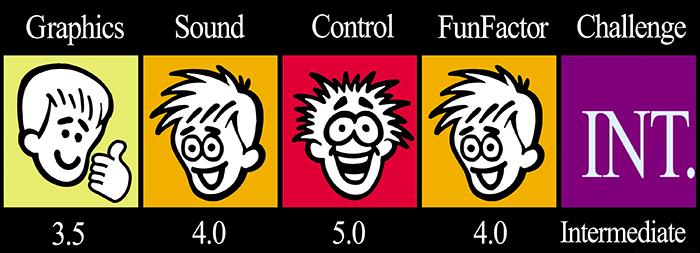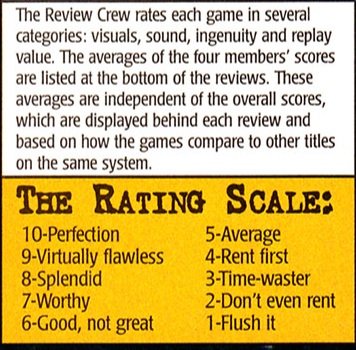Swords and (review) scales
Guest contributor Darren Hupke looks back at the various reviews scores and scales magazines utilised to stand out from the competition.
The review sections of gaming magazines were often the most read and discussed portion of the whole issue. Nothing caused more debate than comparing scores for your favourite titles across various publications.
Magazine knew this, and each publication developed its own unique scoring and review system to help it stand out from the competition. These were often a key component of the magazine’s broader personality, which is something I covered in a previous article.
Anyway, I want to take us back to the 90s, and take a closer look at the most popular magazines from the US and break down their review scales. What standards did they use? What unique takes did they have? And what memorable scores did they give to some historical titles? Let’s find out.
Electronic Gaming Monthly (EGM)
The goal of a video game review is to help players decide how to spend their money. Afterall, no one wants to waste their money on a lousy game.
But these same reviews could take on a greater significance back in the day. For starters, they tended to fuel the playground debates of our youth.
As a preteen, everything is a competition with your friends. I had arguments and debates over EVERYTHING with my friends. Sega versus Nintendo. McDonalds versus Burger King. I can even remember having a heated debate over Duracell versus Energizer.
But our favourite topic of debate was EGM reviews.
EGM’s review crew used a 4-person review panel for each title. A system they lifted from the Japanese publication Weekly Famitsu.
Each reviewer rated the game on a 10-point scale (later allowing for half points as well). A 5 was considered an ‘average’ score and games that averaged an 8 or higher would receive a silver or gold award.
Eventually, games that averaged a perfect 10 across the board would be given a platinum award, but EGM was fairly strict with their scores, and some famous games missed out on this title.
They eventually addressed this in issue #106, with an article by editor Crispin Boyer explaining that the requirements for a 10/10 score were being revised, and that it no longer meant a game was ‘perfect’.
Still, those high standards meant that EGM was always seen as a trustworthy source of reviews. And the scores gave us plenty of debate fuel over the years.
Notable reviews:
• Metal Gear Solid (PlayStation). This was the game that brought back the platinum award from the review crew and scored four straight 10s.
• Pokemon (GameBoy). The phenomenon all started with this release, and while it did impress, the crew only awarded it with a silver award after scoring it 9/8/8/9.
• Legend of Zelda: Ocarina of Time (N64). Another 1998 game and another platinum award. 10/10/10/10. One of the greatest games of all time getting the respect it deserves from EGM.
• Mortal Kombat Advance (GBA). While the review scale goes from 0-10, I rarely saw games with 1s or lower. This title may be the worst reviewed in the entire magazine's history, scoring a 0.0/1.5/0.5 (in later years the review crew panel was reduced to three people).
GamePro
GamePro was another staple in the US gaming magazine market. Their 1-5 review scale was memorable for using cartoon faces to represent scores. But it's worth noting that this wasn’t introduced until issue #15 (October 1990).
The ‘5’ score always stood out on their pages. The bright red colour and the animated face with dishevelled hair was hard to miss. Their average score was a 3, and they also used half points to stretch their scale.
GamePro would also incorporate a ‘fun factor’ score with each review. The idea being that a game’s overall impact and actual gameplay was just as important as its technical qualities. So while a game could have average graphics or sound, if it all came together and the sum of its parts were enjoyable, the fun factor would be able to ‘break’ the scale.
I always appreciated GamePro’s reviews and loved the fun factor scale. There would even be game releases that shared their GamePro review as a callout on the back of the box. That is how much of an impact GamePro had on the industry.
Notable reviews:
• Lakers vs. Celtics (Genesis). This is the first game that received straight 5s for all categories scored. Back then, they rated graphics, sound, gameplay, fun factor, and challenge. Eventually, they would drop ‘challenge’ from their reviews and only use the other categories.
• Battle Arena Toshinden URA (Saturn). The original PlayStation version was praised, as it was an early look at 3D technology and a launch title for the system. The sequels less so, and this Saturn version that “enhanced” the sequel received the lowest score ever, being the first game to go below 1.0, getting a 0.5 score for its fun factor.
• Half-Life (Dreamcast). Don’t get confused; you are reading that correctly. Half-Life was famously cancelled late into its development for the Dreamcast, but GamePro had a reviewable build given to them by the game’s publisher. Shortly after the issue went to print, they were contacted that the game was cancelled, but it was too late, and the issue shipped. They ended up giving the game a glowing review. Too bad it never really existed.
NextGen
Including NextGen (or Next Generation) in this article may be odd. Their focus was unique in its broader take on the industry, larger features, and in-depth discussions that other magazines couldn’t compete with. But they still reviewed games in each issue, and that included platforms that many others just outright skipped. The magazine got its start as a US affiliate of the UK EDGE magazine and even shared some staff.
While many other magazines lead with reviews as their primary section, NextGen typically had them in a unique column-style format at the end of the issue. They utilised a 5- star scoring system and had 2-star reviews considered average on their scale. They also didn’t aim to review every title released that month, but they were selective in covering more obscure or interesting titles.
Notable reviews:
• Burn:Cycle (CDi). While Burn:Cycle isn’t a memorable game per se, it was covered in NextGen’s first issue and is unique because it was released on the often forgotten and/or poorly remembered CDi system. What other magazines released in the 90s covered the CDi? They scored the game 3-stars, if you’re curious.
• Jet Grind Radio (Dreamcast). This is another unique entry, as NextGen would review Japanese copies of some games and had a way to denote when they did. Other magazines did this as well, but it wouldn’t be clear if they were reviewing a potentially different copy. They reviewed Jet Grind Radio under its Japanese name, Jet Set Radio. They enjoyed it and scored it 4-stars.
• Silent Hill (PlayStation). Silent Hill was received positively by nearly all the magazines of the era, NextGen loved it with a glowing 5-star perfect score. They had evolved out of the small column review style, and select games got larger spreads. Silent Hill was featured as a full two-page review, saved for only the best games.
• Dungeon Keeper (PC). Again, coverage of PC titles and not just home consoles kept NextGen in a unique space. The game received a glowing 5-star review. Dungeon Keeper was notoriously delayed and is noteworthy for being Peter Molyneux’s last game he worked on at Bullfrog, the game's developer. After its completion, Molyneux founded his own company, Lionhead Studios, and went on to develop another notoriously delayed game, Fable.







